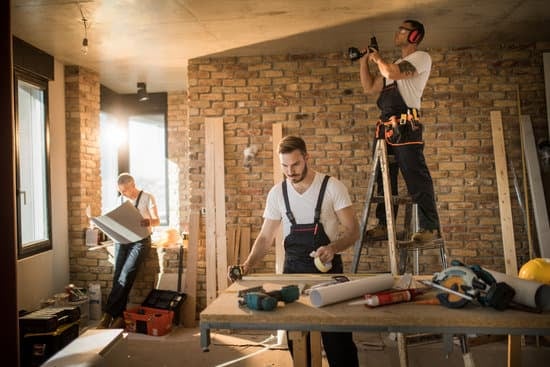Is your home starting to feel lackluster and outdated? It’s time to transform your space and breathe new life into it. In this article, we will guide you through the process of improving a dated home. Whether it’s an old house that has lost its charm over the years or a more recent build with design choices that have become passé, there are plenty of ways to update and modernize your living space.
First and foremost, it is important to understand the challenge that comes with renovating a dated home. The task may seem overwhelming at first, but with proper planning and strategic decision-making, you can achieve remarkable results. From assessing the current state of your home to budgeting for renovations, we will take you step by step towards creating a fresh and inviting environment that reflects your personal style.
Before diving into the renovation process, it is crucial to assess the current state of your home. This involves identifying the key areas that need improvement. Is it outdated wallpaper in the living room? Or perhaps worn out flooring in high-traffic areas? By pinpointing these problem areas, you can prioritize where to put your time, effort, and resources for maximum impact.
Improving a dated home also requires careful consideration of your budget. Determining your financial limits and priorities will help you make informed decisions about where to invest your money. With strategic renovations, creative painting ideas, lighting upgrades, and smart technology integration, you can transform even the most outdated spaces into something fresh and trendy.
Join us on this journey of revitalizing and transforming your dated home. Through practical tips, design inspiration, and expert advice on everything from wall treatments to landscaping updates, we will guide you towards creating a beautiful space that reflects your personality while boosting your overall home value. Let’s dive into this exciting process together.
Assessing the Current State
When faced with a dated home, it is crucial to begin the improvement process by assessing the current state of your property. Taking the time to identify the key areas that require attention will help you prioritize your efforts and allocate your resources effectively. Here are some steps to follow when assessing your home:
- Start with an overall inspection: Begin by conducting a thorough inspection of each room in your home. Look for signs of wear and tear, such as peeling paint, cracked tiles, or outdated fixtures. Take note of any areas that may need immediate attention due to safety concerns or structural issues.
- Consider functionality and flow: Assess how well each space in your home functions and flows from one room to another. Identify any areas where improvements could be made to enhance efficiency and improve livability. For example, outdated kitchen layouts or cramped bathrooms may benefit from a redesign.
- Evaluate aesthetic appeal: Take a critical look at the aesthetic appeal of each room. Consider factors such as outdated wallpaper, faded carpeting, or mismatched furniture. Determine which areas would benefit most from cosmetic updates to bring them in line with modern aesthetics.
Once you have thoroughly assessed the current state of your home, you will have a clear understanding of which areas require improvement and can prioritize accordingly. This assessment will serve as a blueprint for your home improvement journey and guide you towards making informed decisions about where to invest your time and resources.
Remember that every home is unique, so it’s essential to tailor your assessment to fit your specific needs and goals for improvement. By taking these initial steps in assessing your dated home, you are setting yourself up for success in transforming it into a more functional, aesthetically pleasing space that meets both your practical needs and personal style preferences.
Budgeting for Success
When it comes to improving a dated home, one of the most crucial steps is determining your financial limits and priorities. It’s important to have a clear understanding of your budget before embarking on any renovation project to avoid overspending and unnecessary stress. Here are some tips to help you effectively budget for a successful home transformation.
- Assess your financial situation: Start by evaluating your current financial standing. Take into account factors such as your income, expenses, savings, and any other financial commitments you may have. This will give you a realistic picture of how much money you can allocate towards renovating your dated home.
- Prioritize the key areas: Identify the key areas in your home that require immediate attention. These could include outdated fixtures, damaged or worn-out flooring, or old appliances. Make a list of these areas in order of priority so that you can allocate more funds accordingly.
- Research costs and set a budget: Once you have assessed your financial situation and prioritized the key areas, research the average costs for each renovation project. This will give you an idea of how much you need to budget for each area and help you avoid any surprises along the way. Set a realistic budget based on these cost estimates and stick to it as closely as possible.
To further assist with budgeting, consider creating an itemized list of expenses for each renovation project so that nothing is overlooked or underestimated. This will enable you to track your spending more effectively and make adjustments if necessary.
Remember, budgeting for home renovations requires careful planning and consideration. By determining your financial limits and priorities from the beginning, you’ll be better equipped to make informed decisions throughout the renovation process while keeping within your means.
Strategic Renovations
Renovating a dated home can be a daunting task, but with strategic renovations and cunning design choices, it is possible to transform outdated spaces into modern and stylish areas. This section will provide useful tips and ideas for making smart renovation decisions that will have a significant impact on the overall look and feel of your home.
Focus on the Key Areas
When renovating a dated home, it’s important to prioritize which areas need improvement the most. Start by assessing spaces that are heavily used or have the most noticeable signs of aging, such as the kitchen or bathroom. These high-traffic areas are usually worth investing more time and money in to achieve maximum impact. Consider updating cabinets, countertops, fixtures, and appliances for a fresh and modern look.
In addition to the essential spaces, take a close look at any architectural features that may be compromising the overall aesthetic appeal of your home. For example, if you have outdated or worn-out crown molding, swapping it out for something more contemporary can instantly uplift the entire space. Small changes in overlooked areas like light fixtures or door handles can also make a big difference in giving your home an updated feel.
Mixing Old and New
While renovating an outdated home, striking a balance between maintaining its original character and incorporating modern elements is important. A successful renovation respects the bones of the house while infusing it with fresh design choices. Consider using materials like reclaimed wood for flooring or exposed brick walls to bring warmth and character to your space.
Another way to blend old and new is through thoughtful color palettes. Choose neutral colors as a base while adding pops of bold hues through accent pieces or statement furniture. This approach allows you to keep timeless elements intact while still embracing contemporary design trends.
Maximize Storage Space
Outdated homes often lack sufficient storage space, which can lead to cluttered living areas. When renovating, it’s essential to address this issue and find creative solutions for maximizing storage. Built-in shelving, under-stair storage, or utilizing vertical wall space with floating shelves are all great options to consider. These strategic design choices not only provide functional storage but can also add architectural interest to your home.
Reviving the Walls
When it comes to improving a dated home, one area that often gets overlooked is the walls. However, reviving the walls with a fresh coat of paint can dramatically transform the overall look and feel of a space. This section will explore some creative painting ideas that can help breathe life into dull surfaces and give your home an updated and vibrant appearance.
One way to add visual interest to your walls is by using bold and vibrant colors. Instead of sticking with traditional neutrals, consider opting for rich hues like deep blues, emerald greens, or warm oranges. These lively colors can inject personality into any room and create a focal point that draws attention. To avoid overwhelming the space, you can choose to paint just one wall as an accent or use color blocking techniques to incorporate multiple shades.
Another creative painting idea is to experiment with different textures and finishes. For instance, adding a faux finish such as sponge painting or rag rolling can create depth and dimension on your walls. If you prefer a sleek and modern look, you may opt for a high-gloss finish that reflects light and adds a touch of luxury. On the other hand, if you want to create a cozy and rustic ambiance, consider using matte or chalkboard paint.
Lastly, don’t forget about the power of patterns when it comes to reviving your walls. Wallpaper has made a comeback in recent years, offering endless possibilities for enhancing your home’s aesthetic appeal. From geometric patterns to floral motifs, there are countless options available that can complement any style or theme. Additionally, you can also try your hand at stenciling or creating wall murals for a truly unique and personalized touch.
Making thoughtful choices when it comes to painting your walls can have a significant impact on the overall aesthetic of your home. Whether you choose bold colors, experiment with textures and finishes, or embrace patterns, reviving the walls is a cost-effective and relatively simple way to breathe life into dull surfaces. So, grab your paintbrushes and let your creativity flow as you transform your home one wall at a time.
| Creative Painting Ideas | Description |
|---|---|
| Bold and Vibrant Colors | Use rich hues to inject personality and create focal points. |
| Textures and Finishes | Experiment with faux finishes or high-gloss/matte options to add depth and dimension. |
| Patterns | Try wallpaper, stenciling, or murals for unique and personalized touches. |
Bringing in Light and Freshness
Lighting fixtures and window treatments play a crucial role in improving the overall ambiance and freshness of a dated home. By replacing outdated lighting fixtures and upgrading window treatments, homeowners can transform their spaces into brighter, more inviting environments.
When it comes to lighting, there are various options to choose from depending on the desired atmosphere and functionality. One popular trend is installing recessed or track lighting, which provides a modern, streamlined look while offering ample illumination. Pendant lights can also be used to add an eye-catching focal point in rooms such as the kitchen or dining area.
To maximize natural light and create an open feel, it’s essential to upgrade window treatments. Consider replacing heavy curtains or drapes with lighter options like sheer curtains or blinds. These choices allow for better control of privacy and sunlight while maintaining a spacious and airy atmosphere.
In addition to functional upgrades, incorporating smart lighting solutions can enhance convenience and energy efficiency. Smart bulbs and dimmers controlled by voice command or mobile apps enable homeowners to adjust lighting levels based on their preferences. This technology can also contribute to reducing electricity consumption by scheduling lights to automatically turn off when not in use.
Upgrading lighting fixtures and window treatments can make a significant difference in revitalizing a dated home’s overall aesthetic appeal. By embracing these strategies, homeowners can bring in more light and freshness while creating a welcoming space for themselves and their guests.
- Consider installing recessed or track lighting for a modern look.
- Add pendant lights as an eye-catching focal point.
- Upgrade window treatments with lighter options like sheer curtains or blinds.
- Utilize smart lighting solutions for convenience and energy efficiency.
From Outdated to Trendy
Updating the flooring in a dated home can make a huge difference in transforming the overall aesthetic and bringing it up to modern standards. The right flooring choice can completely change the look and feel of a room, making it more inviting, stylish, and functional. Here are some tips and ideas for updating your flooring options to match modern aesthetics.
Consider Hardwood Floors
One of the most popular choices for modern flooring is hardwood. Hardwood floors not only bring a timeless beauty to any space but also add value to your home. With various types of wood, stains, and finishes available, you can choose a style that matches your personal taste and complements the overall design of your home. Whether you opt for classic oak or contemporary bamboo, hardwood floors provide durability and easy maintenance.
Explore Laminate or Luxury Vinyl Plank Flooring
If you’re looking for a more budget-friendly option that still provides the look of hardwood, laminate or luxury vinyl plank (LVP) flooring may be the ideal solution. Both options have come a long way in terms of quality and design, with realistic textures and finishes that mimic natural wood grains. Laminate and LVP are also more resistant to scratches, moisture, and wear than traditional hardwood floors, making them suitable for high-traffic areas like kitchens or entryways.
Embrace Tile Flooring
Tile is another versatile flooring option that can add a touch of elegance to any room while offering durability and easy maintenance. Porcelain or ceramic tiles with sophisticated patterns or unique shapes are popular choices for creating a modern look. Subway tiles or hexagonal tiles are particularly trendy options that can transform a drab floor into a focal point. Additionally, tile is an excellent choice for bathrooms or kitchens since it is water-resistant and easy to clean.
Remember to consider factors such as functionality, durability, lifestyle requirements, and personal preferences when selecting flooring options for your home. Take the time to research different materials and styles, seek advice from experts, and gather inspiration from design resources to ensure you make the best choice that matches your desired modern aesthetic. Updating your flooring can have a significant impact on the overall feel of your home, so don’t overlook this important aspect of revitalizing a dated space.
Small Touches, Big Impact
Revitalizing a home doesn’t always have to involve major renovations or expensive upgrades. Sometimes, small touches and stylish accessories can make a big impact in transforming the look and feel of a dated space. By focusing on adding thoughtful and well-curated decor elements, homeowners can breathe new life into their homes without breaking the bank. Here are some ideas for revitalizing your home with small touches that have a big impact.
Freshen Up with Plants and Greenery
One of the easiest ways to add life to any space is by incorporating plants and greenery. Indoor plants not only provide visual appeal but also improve air quality and create a sense of tranquility.
Include different sizes, shapes, and types of plants to create depth and interest in your interiors. Whether it’s potted succulents on a windowsill, hanging planters in the living room, or a large statement plant in the corner of a room, greenery can instantly rejuvenate your space.
Showcase Artwork and Photographs
Adding artwork or photographs is an excellent way to infuse personality into your home while increasing aesthetic appeal. Choose pieces that resonate with you and complement your existing color palette and style. Large statement art can become the focal point of a room, while smaller frames grouped together create an eye-catching gallery wall. When choosing artwork or photographs, consider the scale of your furniture and walls to ensure proper proportionality.
Upgrade Textiles
Another simple yet effective way to refresh your space is by upgrading textiles such as curtains, rugs, throw pillows, and blankets. These soft furnishings can instantly change the mood and ambiance of a room. Consider introducing different textures, patterns, and colors that complement each other for an added visual interest. Switching out heavier curtains for lighter ones allows more natural light into your home while adding an airy feel.
Revitalizing your home with stylish accessories and decor doesn’t have to be a daunting task. By focusing on these small touches, you can create a refreshed and rejuvenated space that reflects your personal style.
From incorporating plants and greenery to showcasing artwork and upgrading textiles, these simple changes can make a big impact in revitalizing the overall aesthetic of your home. And most importantly, have fun throughout the process as you transform your dated home into a place you love.
Making it Smarter
Smart home technology has become increasingly popular in recent years, offering homeowners the convenience and efficiency of controlling various aspects of their homes with just a few taps on their smartphones or voice commands. Integrating smart home technology into a dated home can not only make everyday tasks easier but also add value to the property.
One area where smart home technology can greatly improve convenience is in home security. Smart security systems allow homeowners to remotely monitor their homes, receive alerts for suspicious activity, and even lock or unlock doors from anywhere. This added level of control and peace of mind can make a significant difference in improving the overall safety and security of a dated home.
Another important aspect to consider when making a home smarter is energy efficiency. Smart thermostats, for example, can learn occupants’ patterns and adjust temperature settings accordingly, leading to potential energy savings. Additionally, smart lighting systems can be programmed to turn off when no one is in the room or dimmed to create a cozy ambiance. These energy-saving features not only reduce costs but also contribute to a more sustainable living environment.
Lastly, integrating smart home technology into a dated home can enhance overall comfort and convenience. For instance, installing voice-controlled virtual assistants like Amazon Echo or Google Home allows homeowners to control various aspects of their homes using voice commands. From adjusting the temperature to playing music or answering questions, these devices offer an easy and efficient way to manage daily tasks.
| Benefits | Examples |
|---|---|
| Improved security | Smart security systems, remote monitoring, and door lock/unlock features |
| Enhanced energy efficiency | Smart thermostats, programmable lighting systems, and energy-saving features |
| Increased convenience and comfort | Voice-controlled virtual assistants, remote control of various home functions |
The Finishing Touches
The exterior of a home is just as important as the interior when it comes to creating a welcoming and appealing space. In this section, we will explore the importance of landscaping, curb appeal, and exterior updates in boosting the overall value of a dated home.
One of the first things that potential buyers or visitors notice about a property is its curb appeal. Improving the exterior of your home not only makes it more attractive, but it also increases its market value. A well-maintained yard with lush landscaping can make a significant difference in how your home is perceived.
There are various ways to enhance your home’s curb appeal. Start by creating a neat and clean entrance by ensuring that walkways are clear and in good condition. Consider adding some colorful flowers or plants to brighten up the front yard and make it more inviting. Repainting your front door or updating it with a stylish new one can also give your home a fresh look.
Another way to boost the value of your dated home is by making exterior updates that align with modern aesthetics. This could include replacing old siding with new materials such as fiber cement or vinyl siding, refreshing the paint on the exterior walls, or adding architectural details like shutters or trim. These updates not only improve the overall appearance but also provide better protection against weather elements and add durability to your home.
In addition to landscaping and exterior updates, it’s important to remember that small touches can have a big impact on refreshing your space. Pay attention to details such as outdoor lighting, house numbers, mailbox, and other accessories that can elevate the overall look of your home’s exterior.
Overall, investing in landscaping, curb appeal enhancements, and exterior updates will not only increase your enjoyment of the space but also attract potential buyers if you decide to sell in the future. By carrying out these finishing touches, you can significantly boost the overall value of your dated home.
| Benefit | Approach |
|---|---|
| Increase market value | Improved curb appeal |
| Create a welcoming atmosphere | Lush landscaping and colorful plants |
| Modernize aesthetics | New siding, refreshed paint, architectural details |
| Attention to detail | Outdoor lighting, house numbers, accessories |
Conclusion
In conclusion, transforming a dated home into a modern and refreshed space is an exciting journey that can greatly enhance your living experience. By following the steps outlined in this article, you can successfully improve the key areas of your home to meet your personal style and current trends. Remember that the process of updating your home takes time and effort, but the end result will make it all worthwhile.
One of the most important aspects of renovating a dated home is determining your financial limits and priorities. Establishing a budget early on will help you make informed decisions about which improvements to prioritize and where to allocate your resources. By strategizing your renovations and making clever design choices, you can transform outdated spaces with minimal costs.
Bringing in light and freshness is another crucial aspect of revitalizing a dated home. Upgrading lighting fixtures and window treatments not only improves aesthetics but also enhances functionality by allowing more natural light into the space. Similarly, updating flooring options can greatly impact the overall look and feel of your home, bringing it in line with modern aesthetics.
Additionally, it’s important not to overlook the small touches that can have a big impact on refreshing your space. Stylish accessories and decor items can add personality and charm to any room. Consider incorporating smart home technology for convenience and efficiency, as well as focusing on landscaping, curb appeal, and exterior updates to boost the overall value of your home.
Ultimately, embracing the journey of transforming your dated home is about enjoying the process as much as the end result. Look at each step as an opportunity for creativity, self-expression, and experimentation.
By taking on this endeavor with enthusiasm and dedication, you’ll be rewarded with a home that reflects your personal style while providing comfort and enjoyment for years to come. So take that first step towards transforming your space – it’s time to turn your dated house into a dream home.
Frequently Asked Questions
How can I make my house look less dated?
To make your house look less dated, start by updating the color scheme. Paint the walls with modern, neutral colors that are currently trending, such as grays or whites. This simple change can instantly freshen up the entire space and give it a more contemporary look.
Additionally, consider replacing outdated fixtures throughout the house, including lighting fixtures, faucets, and doorknobs with more modern options to bring a sense of cohesion and style. Replacing old cabinet hardware with updated designs can also make a significant difference. Finally, pay attention to the flooring – if you have old, worn-out carpets or outdated vinyl floors, replacing them with hardwood or luxury vinyl planks can greatly enhance the overall appearance of your home.
What makes a home look outdated?
A variety of factors can contribute to making a home look outdated. One common feature is an overly specific design style from a certain era that has fallen out of popularity or become associated with a particular time period’s trends. For example, certain types of wallpaper or textured ceilings were popular in the past but are now considered dated and undesirable.
Another aspect that can make a home appear outdated is a lack of modern amenities and technology integration. An obsolete kitchen layout with old appliances or an absence of smart-home devices might give off an antiquated vibe compared to contemporary homes that prioritize functionality and convenience.
What should I fix first in my old house?
When deciding what to fix first in your old house, prioritize structural issues and essential maintenance tasks before moving on to cosmetic updates. Start by assessing any major problems such as leaky roofs or faulty electrical systems that could pose safety risks or cause further damage if left unaddressed. Take care of these issues promptly to ensure the stability and safety of your home before investing time and money into aesthetic improvements.
Once any urgent repairs are complete, focus on enhancing energy efficiency by updating insulation or replacing drafty windows and doors; this will not only improve comfort but also yield long-term cost savings on heating/cooling bills. Afterwards, address any outdated or worn-out fixtures, finishes, or appliances to gradually update and refresh the overall appearance of your old house.

I’m thrilled to have you here as a part of the Remodeling Top community. This is where my journey as an architect and remodeling enthusiast intersects with your passion for transforming houses into dream homes.





